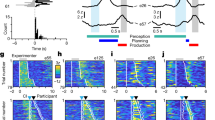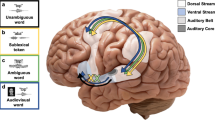Abstract
NEUROLOGICAL evidence has favoured the view that language is a function of only one of the cerebral hemispheres, usually the left hemisphere in right handed people. This aspect of cerebral dominance has been studied in experiments in which it was possible to examine each hemisphere separately for its ability to comprehend language1–2. The subjects in these experiments were patients who had undergone forebrain commissurotomy during therapy for epilepsy3. After such surgery the inter-hemispheric transfer of highly structured visual information is abolished and each hemisphere is restricted to that gained through its primary projection pathways. These subjects were unable to give verbal reports of words presented tachistoscopically in the left visual half field—that is, when the relevant input was to the minor hemisphere. Objects corresponding to the words could be retrieved by touch with the left hand, however, so the minor hemisphere was capable of some measure of comprehension. It was suggested that the lateral specialization lies more in expressive function than in comprehension. After removal of the dominant left hemisphere, a patient has been reported4 to be able to comprehend simple instructions. He could also articulate words and simple phrases. This case may be an exception to the observation that the minor hemisphere is incapable of initiating speech, but, alternatively, the minor hemisphere may be prevented from doing so normally by the influence of the major. If so, speech could perhaps be elicited from the minor hemisphere of the commissurotomy patients in certain conditions. We have used long exposures in the left visual field to take advantage of the effects of temporal summation, while visual input to the major hemisphere is minimized.
This is a preview of subscription content, access via your institution
Access options
Subscribe to this journal
Receive 51 print issues and online access
$199.00 per year
only $3.90 per issue
Buy this article
- Purchase on Springer Link
- Instant access to full article PDF
Prices may be subject to local taxes which are calculated during checkout
Similar content being viewed by others
References
Gazzaniga, M. S., Bogen, J. E., and Sperry, R. W., Brain, 88, 221 (1965).
Gazzaniga, M. S., and Sperry, R. W., Brain, 90, 131 (1967).
Bogen, J. E., Fisher, E. D., and Vogel, P. J., J. Amer. Med. Assoc., 194, 1328 (1965).
Smith, A., J. Neurol. Neurosurg. Psychiat., 29, 467 (1966).
Author information
Authors and Affiliations
Rights and permissions
About this article
Cite this article
BUTLER, S., NORRSELL, U. Vocalization possibly initiated by the Minor Hemisphere. Nature 220, 793–794 (1968). https://doi.org/10.1038/220793a0
Received:
Revised:
Issue Date:
DOI: https://doi.org/10.1038/220793a0
This article is cited by
-
Right hemisphere language ability: 1. Clinical evidence
Current Psychological Reviews (1982)
-
Possible Basis for the Evolution of Lateral Specialization of the Human Brain
Nature (1969)
Comments
By submitting a comment you agree to abide by our Terms and Community Guidelines. If you find something abusive or that does not comply with our terms or guidelines please flag it as inappropriate.



